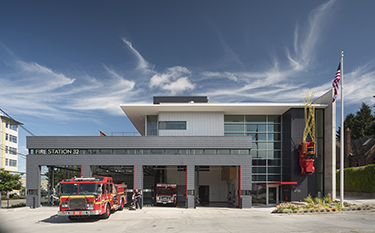|
Subscribe / Renew |
|
|
Contact Us |
|
| ► Subscribe to our Free Weekly Newsletter | |
| home | Welcome, sign in or click here to subscribe. | login |
Construction
| |
 |
March 29, 2018
New green rating systems go way beyond LEED
Brightworks Sustainability

Forney
|
The City of Seattle's Fire Station 32 recently achieved LEED platinum certification — the highest level rating in the world's most widely recognized green building rating system.
It's an ambitious target for any project, let alone a small, publicly owned facility designed back in 2013. This 17,000-square-foot fire station is now a showcase project that makes smart use of public dollars by using solar panels, solar hot water, rainwater capture and a green roof — just about every signature sustainability feature you could want in 2013 — and shows that a more environmentally friendly building can be comfortable, user-friendly and a great investment.
But in 2018, the bar for building green is continually being raised because we are still far from sustainable in the building industry overall. According to the 2017 National Green Building Adoption Index, LEED-certified buildings only account for 4.7 percent of the commercial office buildings across the 30 largest U.S. office markets. The green building segment of the building industry needs to keep growing, but there are also new and higher bars to reach for if you want.
Evolving and new rating systems alike are challenging developers to not just meet higher standards, but to address new issues. And building owners and tenants now find they have a genuinely exciting opportunity: to make their real estate programs and properties reflect their unique values to clients, staff, renters and customers.
New rating systems
The LEED rating system was founded in 2001 — the same year that Brightworks Sustainability began managing sustainability programs in the real estate industry. We have seen firsthand how LEED has become a tremendously important standard for the U.S. and the world, helping define the baseline of green building, and using its power in the market to evolve its standards over time.
But none of these evolutions has been more significant than the recent LEED Version 4. LEED v4 officially took effect for all new projects in 2016, but is still challenging project teams around the world who thought they had green building all buttoned up.
Much of this challenge stems from an increased emphasis on materials-related credits that push the material manufacturing market toward increased transparency and toward a greater understanding of how building materials impact human health. With LEED v4, design and construction teams face new struggles trying to achieve the same certification levels they used to hit with relative ease.
These changes can ruffle feathers, but also serve a vital purpose: to drive the market toward greener, healthier and more efficient buildings. And continued commitment to the evolving rigor of LEED is an opportunity for businesses to communicate leadership and show that they know they can and need to do better.
While LEED has raised the bar for green building in general, there are also a growing suite of topic-specific sustainability rating systems for health, wellness, resilience, energy-efficiency and others. Each system offers the challenge of additional targets to hit, with discrete benefits for those willing to tackle them.
Many corporate real estate programs incorporate green building as a tool to guide more efficient and responsible use of resources, to save money on operating costs, and to put their brand values on display for customers, clients and staff. These topic-specific rating systems offer new ways for private companies and public entities to differentiate themselves from their peers and show leadership in areas that align with their missions.
A focus on health
Alexandria Real Estate Equities is a REIT uniquely focused on collaborative life science and technology campuses. It manages nearly 1 million square feet of Class A office and laboratory space in the Seattle area.
Alexandria was an early adopter of the Fitwel rating system, which was developed by the Centers for Disease Control and Prevention to promote public health outcomes. Fitwel's low-cost approach promotes human health by encouraging buildings to apply lessons from existing scientific research on strategies and techniques that improve public health and wellness.
Alexandria has several Fitwel-certified properties and was the first REIT to become a Fitwel Champion. Brightworks is managing both the LEED and Fitwel certification programs for their new offices at 400 Dexter Ave. N., a great combination to reflect Alexandria's values of sustainability in general, but also of human health in particular.
The Well Building Standard is a more hands-on approach to creating a healthy indoor experience for the occupants of a building. Using in-depth testing of air and water quality, the Well Building Standard certifies buildings that can prove their spaces provide an optimum environment for health, wellness, comfort and cognition.
We've helped numerous clients assess their buildings for opportunities in the Well standard. These clients are interested frequently because their business has a particular stake in promoting human health through its core business, mission or values. Well and Fitwel both offer organizations a genuine real estate differentiator, whether they're saving lives in the life sciences industry, competing to impress top talent in the technology industry, or investing in a genuine change after receiving staff complaints about particularly "unwell" offices of the past.
Resilient design
There are also new tools and frameworks available to offer owners a way to improve how their buildings perform during natural disasters like earthquakes and increasingly extreme weather events caused by climate change. The RELi resilience action list and credit catalog, the REDi Resilience-based Earthquake Design Initiative, and the American Red Cross Ready Rating program offer rating systems specifically for building resilience measures.
We've worked on projects in forward-thinking regions like Boston, New York and Los Angeles that have adopted resiliency measures into their building code to improve the response during the next Hurricane Sandy or Northridge Earthquake, and the benefits can go beyond literal disaster response.
Gerding Edlen's The Eddy apartment building on the Boston waterfront is in a site particularly vulnerable to sea level rise from climate change. The building has a suite of resilience features to bring its systems back to normal within three days of a disaster. The measures not only make residents safer, but also saved Gerding Edlen an estimated $9 million per year in decreased flood insurance premiums, according to the 2015 Urban Land Institute report "Returns on Resilience."
In regions where code hasn't yet caught up to the need for resilient design, these alternatives offer new frameworks for teams in any region to prepare for the specific risks in their geographic area — and for building developers and owners to demonstrate their commitment to exemplary performance in preparation for the escalating effects of climate change.
Business value
The systems I've mentioned are many, yet still just a partial list.
The green building conversation used to revolve around which rating systems would disappear and be absorbed by code. But organizations are increasingly recognizing that topic-specific systems aren't a distraction, but a vehicle to provide deeper and more relevant value for their business and a way of energizing and organizing their staff, clients and customers.
As these rating systems continue to multiply, find what's relevant to you by finding the framework that excites your organization and connects to your business mission.
Chris Forney is a LEED fellow and principal of Brightworks Sustainability.
Other Stories:
- Let’s make buildings people can still use after a disaster
- How cleaner indoor air makes for healthy workers and a healthier bottom line
- Cheap solar energy won't end the need for deep-green buildings
- To meet green goals, cities must grow more strategically
- Asphalt: the go-to material for green paving projects
- Climate change is making resilience a more urgent design priority
- We designed our own net-zero office — and you can, too
- SPU remodel shows even industrial buildings can be green
- Why we can’t reach our emissions goals without tracking embodied carbon



